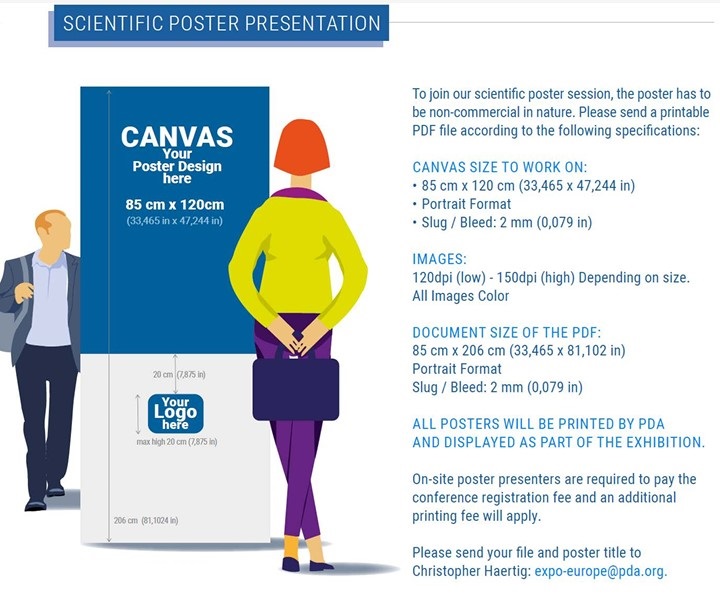Final PDF Poster Submission must be received by 08 May 2026 for consideration.
Poster SubmissionTimeline
-
Final PDF Poster Submission Date
08 May 2026
Deadline for final printable PDF submission
Each abstract must include the following information to be considered:
- Presentation Title
- Presenter's Name And Contact Details
-
Presenter's Biography
(Approx. 100 words) -
Additional Speakers
(If applicable) - Key Objectives of Topic
-
2-3 Paragraph Abstract, Summarizing the Topic
(Max 200 words)
General Information
Abstract submitters may submit up to two entries for consideration.
All presentations must be free of commercial intent. Incomplete proposals will not be considered.
Call for Posters/Case Studies
Types of Submissions
Poster
Accepted posters will:
- Be displayed in the exhibit hall and might be a part of the guided poster walk
Get the Attention you deserve!
Maximize your visibility by contributing a podium or poster presentation at PDA Advanced Therapy Medicinal Products Conference 2026. Leverage this unique opportunity to highlight your work at the event. Posters will be available online post-event.
Topics we are looking for:
- 1. Cell and Gene Products
Gene Modified Stem Cells
Gene Edited Products
CAR T-Cells and other Lymphocytes
Tumor-Infiltrating Lymphocytes (TILs)
Natural Killer Cells
In Vivo Gene Therapy (AAV)
Viral Vectors (GRV, Lentiviral)
Dendritic Cells
mRNA-based Products
- Autologous and Allogeneic Products
iPSC
- 2. Regulatory and Policy Updates
EU GMP Part IV & Annex 1 Revisions
PIC/S Annex 2A/2B Updates
SoHO Regulation
Harmonization in GMO Regulation
Regulatory Requirements for Process Validation
European Health Technology Assessment Regulation
ICH Q5A and Comparability Guidance
Global Regulatory Alignment and Mutual Recognition Agreements
New Pharma Legislation in the EU
- 3. Raw and Starting Materials and Equipment
Cell Lines, Buffers, Proteins, and Complex Raw Materials
Characterization and Life Cycle Management
Application and Delivery Devices
Single-use and Digitalized Equipment
Transition to GMP-grade Materials
Scaffolds, iPSCs, and Media
Packaging Requirements
- 4. Manufacturing
Process Development and Unit Operations
Facility Design, Closed/Open Systems
Viral Vector and mRNA Manufacturing
CMC Strategies and Cost of Goods
Automation and Robotics
Data Management, Digital Twins and AI
Sterility Assurance and Contamination Control
Validation Strategies
Comparability Strategy
Risk Management and Visual Inspection
Emerging Technologies: CRISPR, Exosomes, Lipid Nanoparticles
Technology Transfer
Operator Training and Qualification
Particles
Visual Inspection for ATMPs
Donor Screening
- 5. Logistics and Supply Chain
Chain of Custody/Identity
Cryopreservation and Cold Chain
Shipping Validation and Hold Studies
Supply Chain Labelling and CDMO Management
Operator Qualification and Paperless Systems
Turnaround Time and Site Localization
- 6. Analytical Development and Testing
Bioassays and Potency Testing
Quality Control and Method Validation
Viral Vector Characterization
NGS and Contamination Testing
Comparability and Conditional Release
Alternative and Platform Methods
Automation and Speed in QC
Rapid Methods
Inline Monitoring
- 7. Clinical Aspects
Clinical Trial Design and Immuno-Profiling
Measuring Treatment Response and Potency
Drug Delivery Devices and Companion Diagnostics
Apheresis and Point-of-Care Standards
Correlation Between Manufacturing and Outcome
Novel Oncology Applications
- 8. From Lab to Market
Academic and Commercial Partnerships
Technology Transfer and Scalability
Intellectual Property and Market Frameworks
Innovative Financing and Reimbursement Models
Commercialization Pathways and Risk-Based Strategies
Hospital Exemption vs. Centralized Approval
Phase Appropriateness
- 9. Sustainability
Cost of Goods Reduction
Ecological and Carbon Footprint
Energy and Waste Management
Biosafety and PFAS Alternatives
Sustainability Tools and Culture
Environmental and Occupational Safety
Poster Information
All posters will be printed by PDA and displayed as part of the exhibition.
Please send your final printable PDF file and poster title to expo-europe@pda.org.
Important
Poster presenters are required to pay a full conference registration fee.
Join our guided poster walk in our exhibition hall and gain more visibility. You will have the chance to engage with our audience!
Poster Display Dimensions
Please find the PDF dimension requirements below:
Exhibition and Sponsorship Opportunities
PDA is seeking vendors who provide products/services in support of this conference. Space on-site is limited and is on a first-come, first-serve basis.
Exhibition: 25-26 June 2026
To reserve your space, please contact Christopher Leisterer-Haertig at expo-europe@pda.org.




